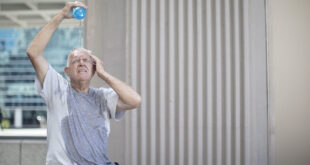After knee injury, surgery or with underlying pathology such as wear and tear, it’s common both as a patient and as a clinician to see major weaknesses of the quadriceps muscles at the front of the thigh, even following long periods of rehabilitation. This is partly due to muscle wasting in some cases, but is also partly due to a phenomenon known as athrogenic muscle inhibition (AMI). AMI occurs in all cases of knee injury, regardless of the underlying problem in the knee.
Why is it important to minimize wasting of these muscles? Because basically, without good quadriceps strength, there is reduced control of the knee during both recreational and every day activities, such as walking and running.
AMI seems to be worse immediately after knee injury or surgery, but it can actually persist for months, and sometime even years. What is interesting, is that studies have found that following knee injury or surgery, this inhibition of the quadriceps muscles occurs in the non-injured leg as well to a lesser degree! What this means clinically, is that both patients and clinicians have to be careful when comparing the strength of an injured to an un-injured leg, as both are likely to be impaired.
So what causes this muscle problem? For a long time, it was thought that AMI was caused by pain and inflammation. It was a bit of a mystery why the quads weakness persisted long after the knee was back to feeling comfortable after an injury. It is now known that the presence of swelling in the knee, in the absence of pain and inflammation, can also cause AMI. In fact, the link between knee pain and quadriceps AMI hasn’t been clearly shown in studies. From clinical studies, it has however been found that just 10ml of fluid is enough to cause AMI to be present. This is a very small amount indeed, and would probably not be able to be detected clinically. So we now know then that the presence of knee swelling, even small amounts, can have a powerful effect on quadriceps weakness and inhibition after knee injury/surgery.
So the next important question is: what can we do therefore to minimize AMI? Again from clinical studies, it has been found that local anaesthetic or aspiration of fluid from the knee can help, but unfortunately these interventions don’t always work, nor are they practical from an everyday patient point-of-view. A really interesting piece of research has been carried out however at the Auckland University of Technology here in New Zealand. They found that using ice on the knee (they used bags of partially crushed ice wrapped around the knee for 20 minutes) temporarily reduced the severity of AMI, thereby giving a ‘window of opportunity’ to work on strengthening. This is likely to lead to more effective and quicker strengthening exercises. So the recommendations if you have a knee injury or pathology would be:
- Keep the swelling down in your knee as much as possible by following the well known principles of Rest, Ice, Compression and Elevation (RICE)
- Ice the knee for 20 mins (make sure it’s the knee you are icing, not the quads muscle itself) and then do your quadriceps strengthening exercises immediately following this
- Also work on knee stability and proprioception exercises (ask your physio about these), as they can also minimize AMI)
- In cases of severe persistent swelling, knee aspiration or anaesthetic may be required to further minimize AMI.
References:
Rice, D., McNair, P.J., Dalbeth, N. (2008) Effects of cryotherapy on arthrogenic muscle inhibition using an experimental model of knee swelling. Arthritis Care & Research, 61 (1), 78-83.
Rice, D., Mcnair, P.J. (2010). Quadriceps arthrogenic muscle inhibition: neural mechanisms and treatment perspectives. Seminars in Arhritis and Rheumatism. 40 (3), 250-266.
Rice, D. (2008) Cryotherapy reduces arthrogenic muscle inhibition following experimental knee joint infusion. Clinical Neurophysiology, 119, 90.








Join the Discussion
Type out your comment here:
You must be logged in to post a comment.